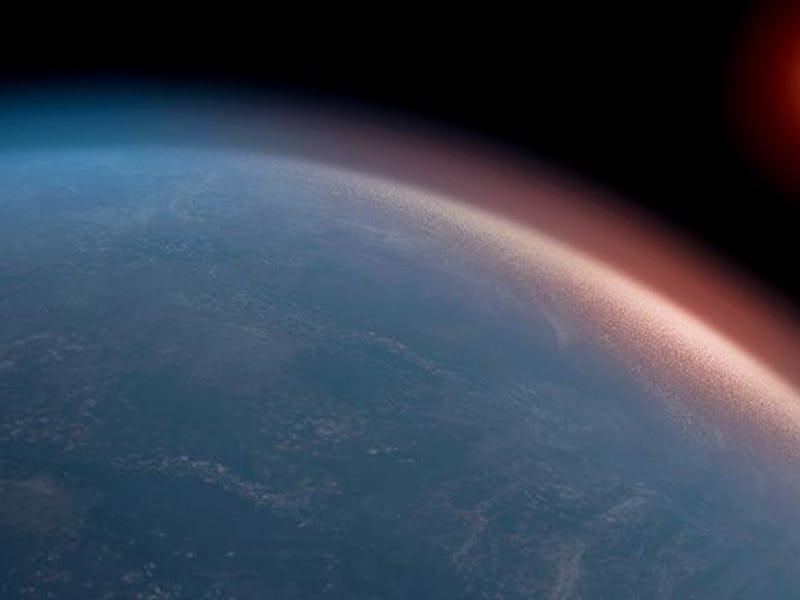This massive Super Earth defies current theories about habitability
Could a mini-Neptune be a true analogue for our home planet?

In the search for other planets that may host life, we tend to look for ones that look like our own.
But a new exoplanet discovery, K2-18b, changes our misconceptions about habitable worlds, proving that massive planets can be welcoming to life too.
In a new study, astronomers detail the first in-depth analysis of the exoplanet’s atmosphere. The results, published this week in the Astrophysical Journal Letters, reveal that though the planet is quite unlike our own, it may be ripe for hosting life.
In September 2019, K2-18b caused a stir when scientists found water vapor in its atmosphere. The discovery marked the first detection of water vapor in a planet outside of our own Solar System, and marked a promising step towards our quest to find an alien world capable of hosting life.
But the findings were not quite enough to prove that K2-18b could host life.
The planet is twice the size of Earth, but it may be capable of hosting life.
In particular, K2-18b’s size made scientists doubt its potential as an analogue for Earth.
The exoplanet is 2.6 times the size, and 8.6 times the mass of Earth. In fact, it is more of a mini-Neptune than an Earth-like planet.
Planets of this size tend to have a thick envelope of hydrogen surrounding a layer of high pressure water in their atmosphere, which may make the temperature and pressure of the water way too intense for life to exist.
But the new findings suggest that the hydrogen envelope is not too thick, despite the planet’s massive size. As a result, the planet's water may be suitable to sustain life.
“We wanted to know the thickness of the hydrogen envelope – how deep the hydrogen goes,” Matthew Nixon, a graduate student at the Institute of Astronomy and co-author of the study, said in a statement.
“While this is a question with multiple solutions, we’ve shown that you don’t need much hydrogen to explain all the observations together.”
For the new study, the researchers used the existing observations of the planet’s atmosphere, as well as its mass and radius, to determine what its atmosphere and inner core were made of.
Their findings confirm that K2-18b’s atmosphere is hydrogen rich, and also suggest that levels of other chemicals such as methane and ammonia are lower than expected for a planet of its size.
One of the study’s models even suggests that K2-18b is an ocean world, with liquid water flowing beneath its atmosphere with similar pressure and temperature as Earth. Only further observations will be able to confirm whether that is indeed the case, however.
Welcome home: K2-18b vital statistics
Discovered in 2015, K2-18b is not truly like Earth, but it is the closest we have got to another Earth — so far.
K2-18b is (relatively, universe-wise) close to Earth. It is located only 124 lightyears away, in the constellation Leo. But it has some crucial differences to our own planet.
It orbits in the habitable zone of a red dwarf star that is itself less than half the size of our Sun. And unlike Earth, this giant planet orbits its tiny star with a period of a little over 32 days.
The planet's inner core could be made up of rock or pure iron, scientists aren't sure. Its atmosphere is mostly composed of hydrogen, while our own is mainly made up of nitrogen.
And yet, despite these massive differences, K2-18b is still the best bet we have in terms of a habitable planet.
“Water vapor has been detected in the atmospheres of a number of exoplanets but, even if the planet is in the habitable zone, that doesn’t necessarily mean there are habitable conditions on the surface,” Nikku Madhusudhan, a researcher at Cambridge’s Institute of Astronomy, and lead author of the new study, said in the statement.
“To establish the prospects for habitability, it is important to obtain a unified understanding of the interior and atmospheric conditions on the planet — in particular, whether liquid water can exist beneath the atmosphere.”
The team of researchers are hoping to use upcoming telescopes such as the James Webb Telescope to improve their observations of the massive planet, and determine whether or not it could be our new Earth.